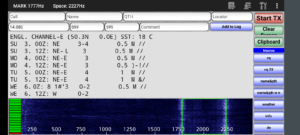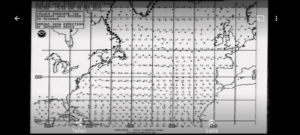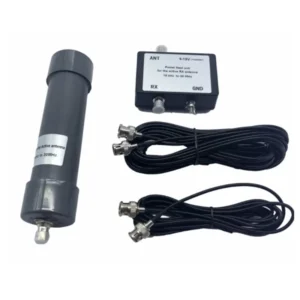Fig. ATS25 X2
I found a very exciting piece of hardware on the Internet that can be used to receive weather faxes and weather reports. It is the small SDR receiver ATS25 X2 for the frequency ranges 100kHz to 30 MHz. The firmware comes from Antonino IU4ALH and is available in version V5.3b.
The box with dimensions of 100 x 100 x 50 mm contains an ESP32 and a SI4735. The receiver can be operated via a color 2.4″ TFT touch display and a turn/push selection wheel. This allows the following frequency ranges to be received:
- FM: 85…108MHz, FM RDS functions
- LW: 153…500 kHz, AM
- MW:520kHz 1710kHz, AM
- SW: 1730…30000 kHz, AM
- SSB: 1730…30000 kHz, USB/LSB
- CB: 26565…27405 kHz, FM (only with latest firmware)
The ATS25 X2 is purely a receiver and cannot transmit. It can be used as a radio for LW, MW, SW and VHF and also supports all amateur radio modes such as SSB for voice, RTTY and Morse. You can also listen to FM radio, even in stereo via the headphone jack. For just under 88 euros you get a small box with an FM antenna and a USB charging cable. The ATX25 X2 has a battery with which it can operate for up to 8 hours. In terms of functionality, the device is extremely well equipped and all operating modes can be operated in great detail, including frequency scanning in the respective reception bands. The heart is an ESP32 in conjunction with the SI7435. The hardware is the absolute minimum that is needed for such purposes. It's impressive what functionality you can get out of such a small device. If you want to take a closer look at amateur radio and don't want to spend a lot of money, the ATS25X2 is a great way to get started.
Decode weather messages and faxes
With the device you can easily receive weather faxes and weather reports via shortwave, as is also possible with a world receiver. With a 10 m long piece of wire as an antenna you are already there and can receive messages on shortwave.
As a test, I used my shrouds and the mast on my boat as an antenna. This works quite well because I have a plastic boat and the shrouds and mast are insulated.
For example, you can receive the following via the German weather service DWD:
- 4583 kHz LSB bet text messages via RTTY, decoder: Wolphi App DroidRTTY
- 3855 kHz or 7880 kHz USB weather faxes via RTTY, decoder: Wolphi app HF Weather Fax
Depending on the reception quality, both weather information can be received quite usably. However, my antenna is not optimal and the reception quality is not particularly good. As a result, some data arrives partially garbled. With a Mini Whip as an antenna it works much better and you don't need such a long antenna.
As a decoder I use the Android apps from Wolphi with which you can decode the signals. To do this, you download the apps onto your cell phone and use the cell phone's microphone to record the beeps, which are decoded by the respective app. In order to be able to optimally adjust the decoder to the tones, the apps have an FFT waterfall graphic. To adjust the frequency, simply move the markers to the visible frequencies. This is very easy and very effective.
Fig.: Android app Droid RTTY
Fig.: Weather fax with wind data decoded with the HF Weather Fax app
Here's another live example of how it works in the end: https://www.youtube.com/watch?v=mr5aSu1-fDw
The linked apps are a bit older, but they are free. Anyone who purchases the apps from the PlayStore for a fee will receive more up-to-date apps. The older versions are also sufficient to test the function.
The ATS25 is available in different versions on Ebay or Amazon:
| Model | Operating modes | antennaadjustment | Sound decoder | USB data output |
Web servers |
chargingrecognition | battery pack |
WiFi | Firmware |
| ATS25 | FM, AM, CW, SSB (USB, LSB) | manually | no | no | no | no | 2200mAh | internal antenna | Antonino V4.0b |
| ATS25X2 | FM, AM, CW, SSB (USB, LSB) | manually | no | no | no | no | 2200mAh | external antenna | Antonino V5.3b |
| ATS25 max | FM, AM, CW, SSB (USB, LSB), CB | automatically | no | no | Yes* | Yes | 4000mAh | external antenna | Bernard V4.16 Air |
| ATS25 Max Decoder | FM, AM, CW, SSB (USB, LSB), CB, RTTY, TF4, TF8 | automatically | Yes | Yes | Yes* | Yes | 4000mAh | external antenna | Bernard V4.16 Air |
* currently not working
Tab.: Model variants
The last model is the most powerful and contains the latest firmware. The RTTY decoder is already included and the text messages can be received via the USB interface. But it costs almost twice as much as the ATS25 X2. The firmware of the ATS25 X2 can also be updated yourself for a fee of around 10 euros. With the help of a small, simple additional circuit, you can also install an RTTY decoder yourself. But this is only for people who are experienced in soldering and are familiar with it.
Fig.: Two-tone decoder for RTTY (gain=50, fo=600 Hz, 14% BW)
If you're interested in trying it out, I can only say that it's a lot of fun. Combined with SDR-Online via the University of Twente You can also get into the topic without hardware and try out the decoder apps.
Mini whip antenna
Fig.: Mini Whip antenna for 10 kHz to 30 MHz
A Mini Whip antenna is an ideal addition to the ATS25 X2. This creates a broadband active antenna that can receive in the 10 kHz to 30 MHz range. This type of antenna is characterized by the fact that the active antenna area is only approx. 30 x 60 mm and is therefore very small and can be easily installed anywhere. However, an additional power supply of 12V is required to operate the antenna. The supply voltage for the active antenna is fed directly into the antenna cable via a feed switch and thus supplies the amplifier circuit in the antenna.
If you would like to know more about this type of antenna, you can follow the link: https://www.dl4zao.de/active_antenna/index.html
Further information about the ATS25 X2 can be found in the sailing forum at: https://www.segeln-forum.de/thread/88565-wetterfax-und-wetternachrichten-mit-ats25-x2/?postID=2559404#post2559404
questions and answers
Can the receiver also receive in the frequency band gaps between 500 and 520 kHz?
Yes, that is possible. Within certain limits, emissions outside the frequency bands can be received. There is a definition file in the firmware in which the frequency bands are defined. The band limits can be changed by adapting this file.
Can I receive below 153 kHz?
The smallest reception frequency is 140 kHz with the firmware supplied for the ATS25 X2.
How can I update the firmware?
The firmware can be updated via the USB interface. To do this you need a special update program. Under harduino.ru The latest firmware for the various ATS25 devices can be downloaded. However, the latest firmware is available for a fee. For around 10 euros you get many additional functions that are not included in the standard firmware, such as the RTTY decoder. Danger! The firmware versions maintained by harduino are numbered differently than the standard firmware.
How can I restore the old firmware V5.3b?
The old firmware V5.3b is open source and can be restored using the Arduino IDE. Download this ZIP file Download and follow the instructions in the file update firmware.txt.
What can I do with WiFi?
The ATS25 X2 also has a WiFi antenna. This allows the time to be synchronized with the Internet. In addition, information about the current propagation conditions for the respective shortwave ranges is loaded and displayed by the receiver in the latest firmware. In the future, it is planned that the firmware update can be carried out via a website and that the receiver can be controlled remotely via USB and WiFi.
Which functions and operating modes does the ATS25 X2 support?
- AGC (Automatic gain adjustment of the antenna signal
- BFO (fine tuning)
- ANT (attenuation of the antenna signal)
- AM, LSB, USB, FM
- Channel scan with pseudo-waterfall graphics
With the ATS25 max decoder The following signals can also be decoded because the device contains the necessary decoders:
- RTTY (45.45 / 50 / 75 baud)
- FIELD-BRIGHT
- FT4 and FT8
Does the ATS25 max decode DWD weather faxes?
The ATS25 max decoder can currently only decode character-based information directly and output it via USB. For weather faxes in F1C mode, external decoders are required, such as the Wolphi app HF Weather Fax. It is conceivable that weather faxes can also be decoded in the future.
Can I receive NAVTEX with the ATS25 X2?
The NAVTEX signal tones can be received with the ATS25 X2 if there is a local Navtex station nearby fixed broadcast times sends out the data. They have a software decoder that converts the sounds into text messages ATS25X2 and ATX25 max decoder Both are not. However, it is possible to output the analogue audio signals via the headphone output and to use an external PC software or mobile app to decode.
How do I have to set up the ATS25 X2 to be able to receive Navtex?
Navtex is broadcast at 518 kHz in the upper sideband (USB) in the Sitor-B. The center frequency is 1700 Hz +/-170 Hz frequency shift. The transmission speed is 100 Bd. The ATS25 X2 is set to 516 kHz with BFO -625 Hz and USB with a filter width of 2.2 KHz. Once the tones have been found, the filter width can be reduced to 1 kHz and the BFO is slightly configured to optimally hear the two tones.
Which Navtex frequency should I use?
The Navtex information is in individual regions in the world divided up. On 518kHz Messages are always sent out in English. The reports in the regional language, however, are published 490kHz sent out.
Do I need antenna grounding on my boat?
An antenna grounding on the boat is not absolutely necessary. A long wire approximately 6...10m long, such as a backstay, is sufficient to receive weather reports in the 60...80m band. If you want to achieve better reception, such as is required for Navtex, you should work with a Mini Whip antenna. This gives you a powerful antenna that takes up little space and can be installed anywhere.
Where can I find information about the hardware?
On the Github page by Antonino IU4ALH you will find plenty of information about the hardware and software of shortwave receivers with an ESP32 and a SI4735. The ATS25X2 is based on open source projects and is structured in a similar way. And at this point you can find one Comprehensive evaluation of the ATS25 receivers with different software versions.
Where can I get the additional hardware to decode the RTTY signals?
You can either assemble the additional hardware on a breadboard or have a board made and then populate it yourself. The Gerber data for the board can be found on the website Antonino IU4ALH Download it and order it from a circuit board manufacturer. At Aisler is the manufacturing data The unequipped circuit board is already stored and can be ordered directly.
How good is the decoding quality of the ATS25 max decoder?
The decoding quality of the built-in one-tone decoder is not as good as the two external app variants. Significantly more errors occur. This is because only one tone, which must be set exactly to 800 Hz, is evaluated. The app variants use both tones and can decode the signal more reliably. This is particularly noticeable in changeable reception conditions. From a signal strength of 6 bB, the one-tone decoder works quite well and the text messages can be read directly via USB using external software. The volume should not be set too loud for the decoder to work correctly, otherwise the noise will increase significantly. The safest way to decode is with the two app variants.
Why can't I integrate the ATS25 into my WiFi network?
When logging into the WiFi network with the latest firmware V4.16 Air, the access code must be entered via the touch display. However, you cannot see what you are entering because the characters are hidden behind an asterisk. When typing with the pen, characters may accidentally be entered twice. Check the display to see how many characters have been entered and if there are any errors, enter the code again. It often helps not to use the pen too hard to make entries.




